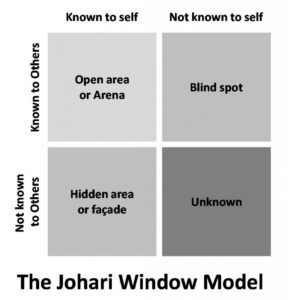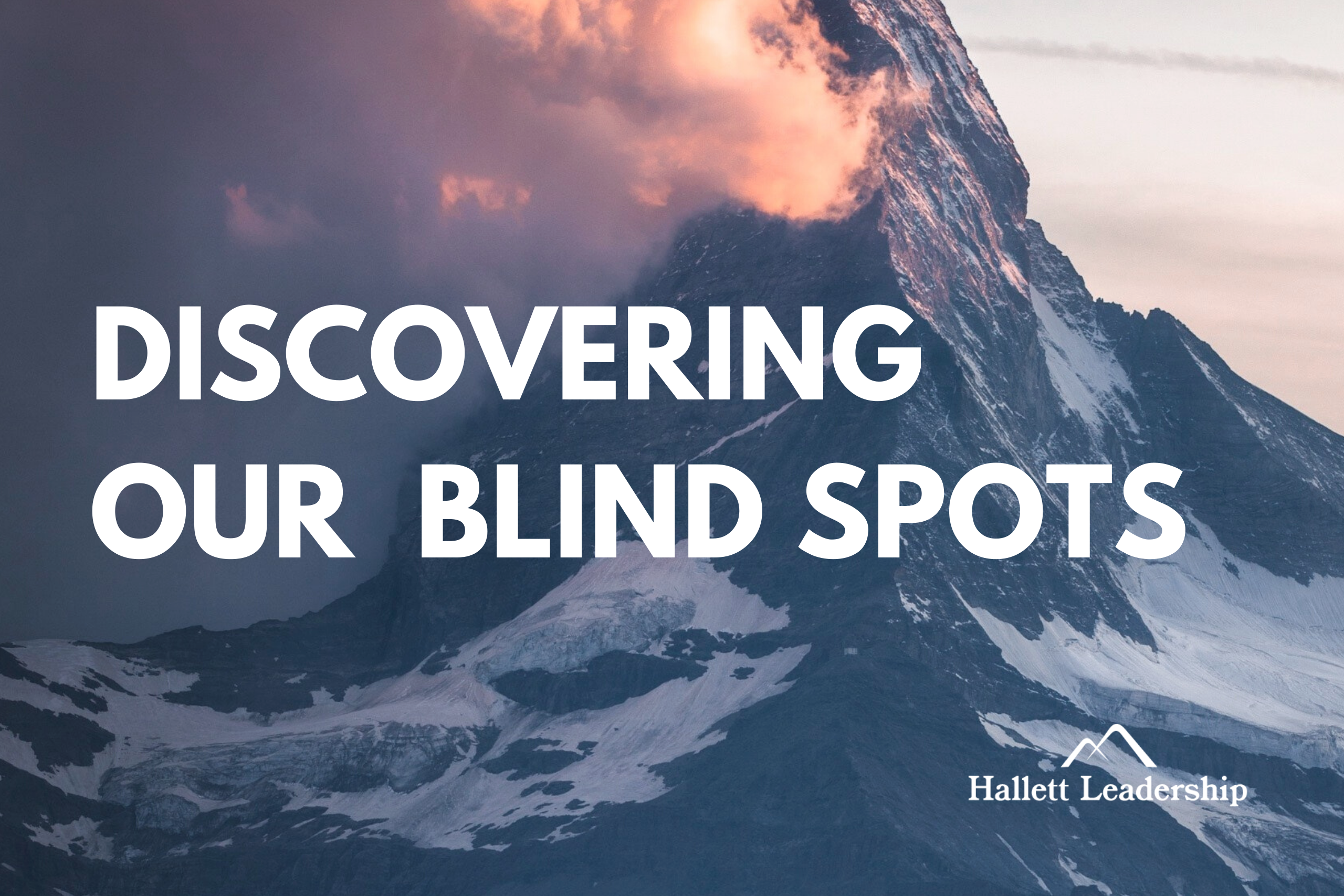Participants in Hallett Leadership’s Accelerated Leadership Program report back that one of the most impactful experiences in the program is the opportunity to participate in feedback exchanges with their peers. Why? Because through feedback exchanges and the process of collaboration, each participant gets an opportunity to learn what they don’t know about themself.
There’s a word for parts of ourselves that we are not aware of: blind spots. Everyone can gain from learning about their own blind spots – and leaders particularly stand to benefit, because any growth they experience will influence the departments and people that they lead. The Johari Window is a well-known map that can be used to understand the paradigm of the blind spot.
A Few Common Leadership Blind Spots
There are many blind spots to choose from – here is a brief sampler of blind spot examples that surface among managers and leaders.
Not Standing Up For Something Perceived As Important
Leaders and managers can stand in a challenging position as they weigh and attempt to reconcile the needs and priorities of their bosses and the people who report to them. The best course of action isn’t always obvious. Therefore, there may be times when, in order to play it safe, a leader may not stand up for something that their team members and employees perceive as important.
In the early days of the Accelerated Leadership Program at FOX, I participated in feedback sessions with trainees, and I received this exact piece of feedback – that I had not taken a stand on an issue that others perceived as important, and that my team members wanted to be able to rely on me as a champion in their corner.
As a person who was more conservative and introverted by nature, I didn’t realize at the time the degree to which my team members looked to me for strength and moral support. This was one of the most important instances in my career of being made aware of a blind spot. From then on, I understood that I was called, for the sake of my team members, to be courageous and take the best-thought-out stand that I was capable of on complicated or sensitive issues.
Having an “I know all of this already” Attitude
We recently told the story of an Accelerated Leadership Program trainee, who put other members of her team off by having an “I know all this already” attitude to the training program. She meant no harm by her attitude. From her point of view, she had gone through more training experiences than her teammates had – but her teammates perceived that she was placing herself above them. Therefore, many in the cohort nursed a degree of resentment towards her, which when it was finally expressed in a feedback session, came as a total surprise to her.
Being perceived as arrogant or considering oneself superior to others can be a very harmful blindspot to productivity and even the progression of an individual’s career. If receiving feedback from your teammates is one of the most powerful (and cost-effective) management tools, then this particular blind spot is one of the most important to bring to someone’s awareness – for their benefit, and to the benefit of the entire team.
Being Unaware Of The Impact Your Behavior Is Having On Others
This blind spot is more general than the two aforementioned, and could include both of them. In a broadest sense, the reason it is valuable to become aware of what is in our blind spots is because of how they are affecting the people around us. Our relationships with people greatly influence our lives and careers.
In this example, we could be speaking too harshly to a person or group of people and not realize it because we are so focused, or moving so quickly in the course of the day. Or we could be neglecting to thank or acknowledge members of our teams for their contributions.
I have also received this particular piece of feedback in the past. I had been moving through the days simply expecting high levels of performance from my team because I expected that of myself. I wasn’t acknowledging people enough, and this affected the team I was leading. When someone revealed this blind spot to me, I began to prioritize acknowledging and thanking people for their contributions. It has made a huge difference in my life – in and out of the office.
The Johari Window

The Johari Window is a quadrant-based system on two intersecting axes that visually represents all the different ways that we can be perceived. It is a useful map for understanding what blind spots are, and how to become aware of them.
Here is what the Johari Window is representing:
Along the X axis we have what is known to oneself, and what is not known to oneself.
Along the Y axis we have what is known to others, and what is not known to others.
The upper right quadrant where what is not known to oneself intersects with what is known to others is the quadrant called the blind spot. The blind spot by its nature is incredibly difficult, or even next to impossible to become aware of on our own.
Unless we intend to spend long periods of time in meditation or contemplation of our blind spots, hoping for a window of grace to reveal them to us, then the fastest and most efficient way to become aware of our blind spots is simply to ask the people nearest us to tell us what they see – through feedback sessions.
Finally, it is very important to mention that blind spots don’t only pertain to negative aspects of ourselves. We can also have positive traits or behaviors that we are unaware of. If someone appreciates something about me, and I am unaware of it, then becoming more conscious of that thing can prove very valuable to me. It can help me improve my relationships even more.
Or perhaps I am performing a certain role in my company, with a certain scope of work – but I have a gift for something else that is evident to other people, but that I am blind to because it comes naturally to me.
In my own career, I began as an accountant, and have become a coach, mentor and facilitator. I wouldn’t have known that I was inclined toward developing human potential in work teams had I not received positive feedback from successful initial attempts that I was moving in the right direction. That positive feedback came in the form of (a) my personal enjoyment of coaching and facilitating, and (b) the success of the training programs and an increase in demand for them – first at FOX, and then later with Hallett Leadership.
So don’t ever forget that learning about our blind spots isn’t only about what to DELETE from our lives, but what to KEEP and CREATE NEW as well.
How To Apply The Johari Window
The process of applying the Johari Window begins with bringing people together into the same room and facilitating some ice breakers. Tell them that in order to grow and to develop stronger bonds, everyone will be engaging in a feedback exercise in order to support each other in becoming more effective contributors and people, in and out of the workplace.
Within this frame, introduce the concept of the blind spot, so that they understand what it is, and the personal and professional value of identifying blind spots.
Having set the stage, facilitate the feedback session with these two prompts:
“What I really appreciate about you is ________.”
“What would make you even more effective would be ________.”
Then have each person seek out a partner to exchange these statements with. Have the members of the group repeat as many times as necessary so that everyone has a chance to pair up with everyone else.
If your group exceeds ten people, and having each person pair with each isn’t realistic given your time constraints, then conclude as soon as members of the group have had the opportunity to connect with a sufficient number of people.
In other words, have they been afforded enough time to provide feedback to the people they most want/need to connect with?
The final stage of the process is the debrief, in which you elicit discussion from group members on what the feedback session was like for them. There may be some kind of larger group discussion to be had related to feedback that emerged during the session.
An effective way to close is for the group to be given a couple minutes to take down some written notes and comments about the session.
Conclusion
Remember that the purpose of revealing our blind spots is not to be criticized, but to grow in awareness and increase the number of options we have for engagement and response in any given situation. Hopefully, with more options, we can improve our relations with co-workers, clients and customers, and live more aligned, thoughtful, and effective lives.
Please reach out if we can support you in the process of developing self awareness among your corps of developing leaders.





